German South West Africa
Quote from Steve on July 9, 2025, 12:52 pmSome early-ish GSWA Postcards.
It's about time we had a dedicated German South West Africa section.
I recently bought three GSWA (German South West Africa) postcards in the SACS (South African Collectors' Society) auction. They are of interest to me because they show early historic views of the German colony. As a bonus they also bear German Reich stamps over-printed 'Deutsch-Sudwestafrika' (second issue). I include all three for your edification and, hopefully. delight.
The first's a cracker! It shows 'Settlement house with Post Office in Swakopmund'. While not a major discovery, it excites me. It shows the exact building in Swakopmund where GSWA mail originated and or transited through en route inland or overseas. This postcard was posted in Karibib on '1 / 7 00'. To get it in perspective, the Swakopmund Post Office opened on 30th May 1895. The Swakopmund - Windhoek railway line only reached Windhoek on 19th June 1902, some two years after this postcard was posted.
According to Ralph Putzel's 'Comprehensive Handook of the Postmarks of GSWA / SWA / Namibia' (page 114), the building shown is "the first post office in Swakopmund". Putzel does not include this particular postcard view in his reference. Perhaps he thought his the better view because it shows a faint sign 'KAISERL. POSTAMT' above the door. I like the manuscript annotations on my postcard!
1900. Postcard. 'Settlement house with Post Office in Swakopmund'.
(2065. Verlag Rascher & Thielecke, Swakopmund'.) It is variously annotated top left clockwise:
'Settlement house', 'Post Office', 'To the Inn', 'To the Sea', and centre left 'To the desert'.But wait, this postcard gets better!
1900. 'KARIBIB '1 / 7 00' to MUNICH, Germany.
Note: This is a clear strike or Karibib's first permanent datestamp.
According to Putzel, it was supplied on 1. 7. 1900, the date of use above.
This postcard was included in the first mail dispatch from Karibib using its new datestamp!!!Below is the image of the Swakopmund Post Office which Putzel shows in his book. Because the corrugated-iron shack on the right of the postcard above appears to have been replaced by a plastered structure and everything seems more established and settled I assume that Putzel's image was taken later than the one above ie. the postcard shows the earlier view.
Scan ex-Ralph Putzel's 'Comprehensive Handook of the Postmarks of GSWA / SWA / Namibia' (page 114).
The three postcards I purchased were sent to the same address by the same sender. They are not presented here in date order. The second postcard is interesting in that it was cancelled in Swakopmund in the Post Office shown above a week earlier.
1900. Postcard. 'Greetings from Swakopmund'.
(2188. Verlag M. Gluckstadt & Munden, Hamburg'.)
1900. 'SWAKOPMUND '25 / 6 00' to MUNICH, Germany.
Note: This is Swakopmund's first permanent datestamp.The third postcard shows the German Military Hospital, 'The Lazareth'. in Windhoek. See next post. Unfortunately I cannot show it here because we are limited to five images per post.
Some early-ish GSWA Postcards.
It's about time we had a dedicated German South West Africa section.
I recently bought three GSWA (German South West Africa) postcards in the SACS (South African Collectors' Society) auction. They are of interest to me because they show early historic views of the German colony. As a bonus they also bear German Reich stamps over-printed 'Deutsch-Sudwestafrika' (second issue). I include all three for your edification and, hopefully. delight.
The first's a cracker! It shows 'Settlement house with Post Office in Swakopmund'. While not a major discovery, it excites me. It shows the exact building in Swakopmund where GSWA mail originated and or transited through en route inland or overseas. This postcard was posted in Karibib on '1 / 7 00'. To get it in perspective, the Swakopmund Post Office opened on 30th May 1895. The Swakopmund - Windhoek railway line only reached Windhoek on 19th June 1902, some two years after this postcard was posted.
According to Ralph Putzel's 'Comprehensive Handook of the Postmarks of GSWA / SWA / Namibia' (page 114), the building shown is "the first post office in Swakopmund". Putzel does not include this particular postcard view in his reference. Perhaps he thought his the better view because it shows a faint sign 'KAISERL. POSTAMT' above the door. I like the manuscript annotations on my postcard!
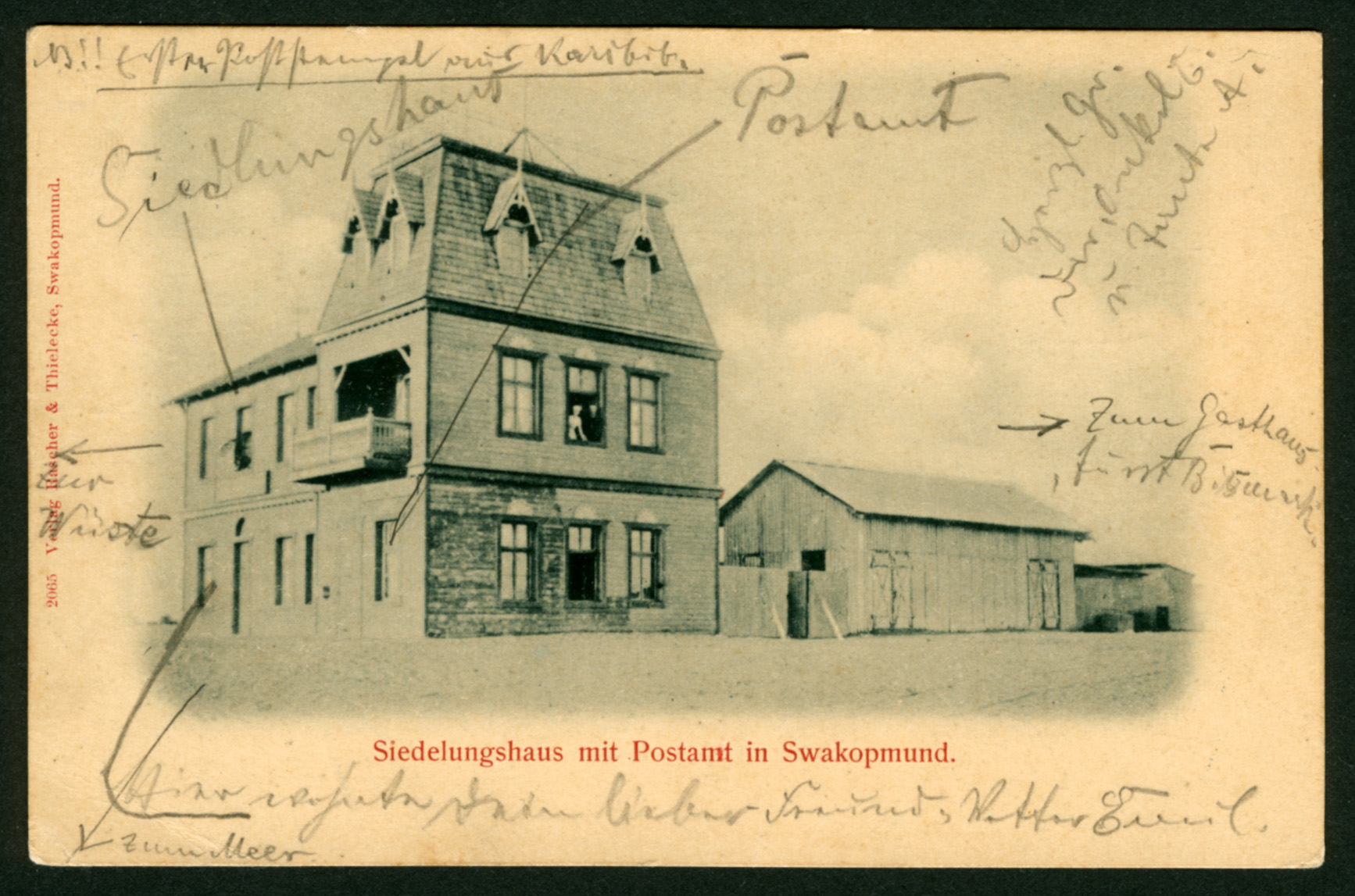
1900. Postcard. 'Settlement house with Post Office in Swakopmund'.
(2065. Verlag Rascher & Thielecke, Swakopmund'.) It is variously annotated top left clockwise:
'Settlement house', 'Post Office', 'To the Inn', 'To the Sea', and centre left 'To the desert'.
But wait, this postcard gets better!
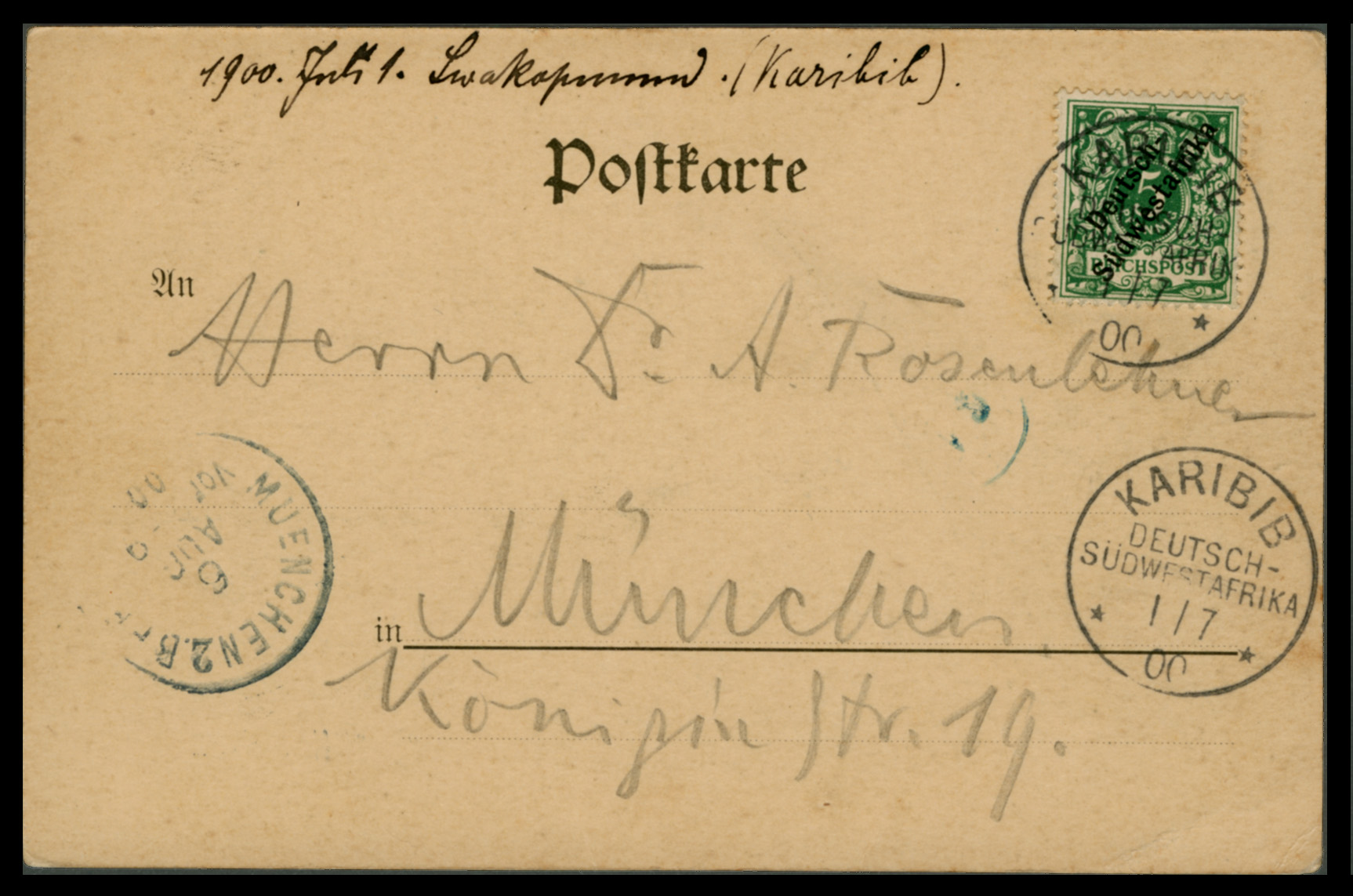
1900. 'KARIBIB '1 / 7 00' to MUNICH, Germany.
Note: This is a clear strike or Karibib's first permanent datestamp.
According to Putzel, it was supplied on 1. 7. 1900, the date of use above.
This postcard was included in the first mail dispatch from Karibib using its new datestamp!!!
Below is the image of the Swakopmund Post Office which Putzel shows in his book. Because the corrugated-iron shack on the right of the postcard above appears to have been replaced by a plastered structure and everything seems more established and settled I assume that Putzel's image was taken later than the one above ie. the postcard shows the earlier view.

Scan ex-Ralph Putzel's 'Comprehensive Handook of the Postmarks of GSWA / SWA / Namibia' (page 114).
The three postcards I purchased were sent to the same address by the same sender. They are not presented here in date order. The second postcard is interesting in that it was cancelled in Swakopmund in the Post Office shown above a week earlier.
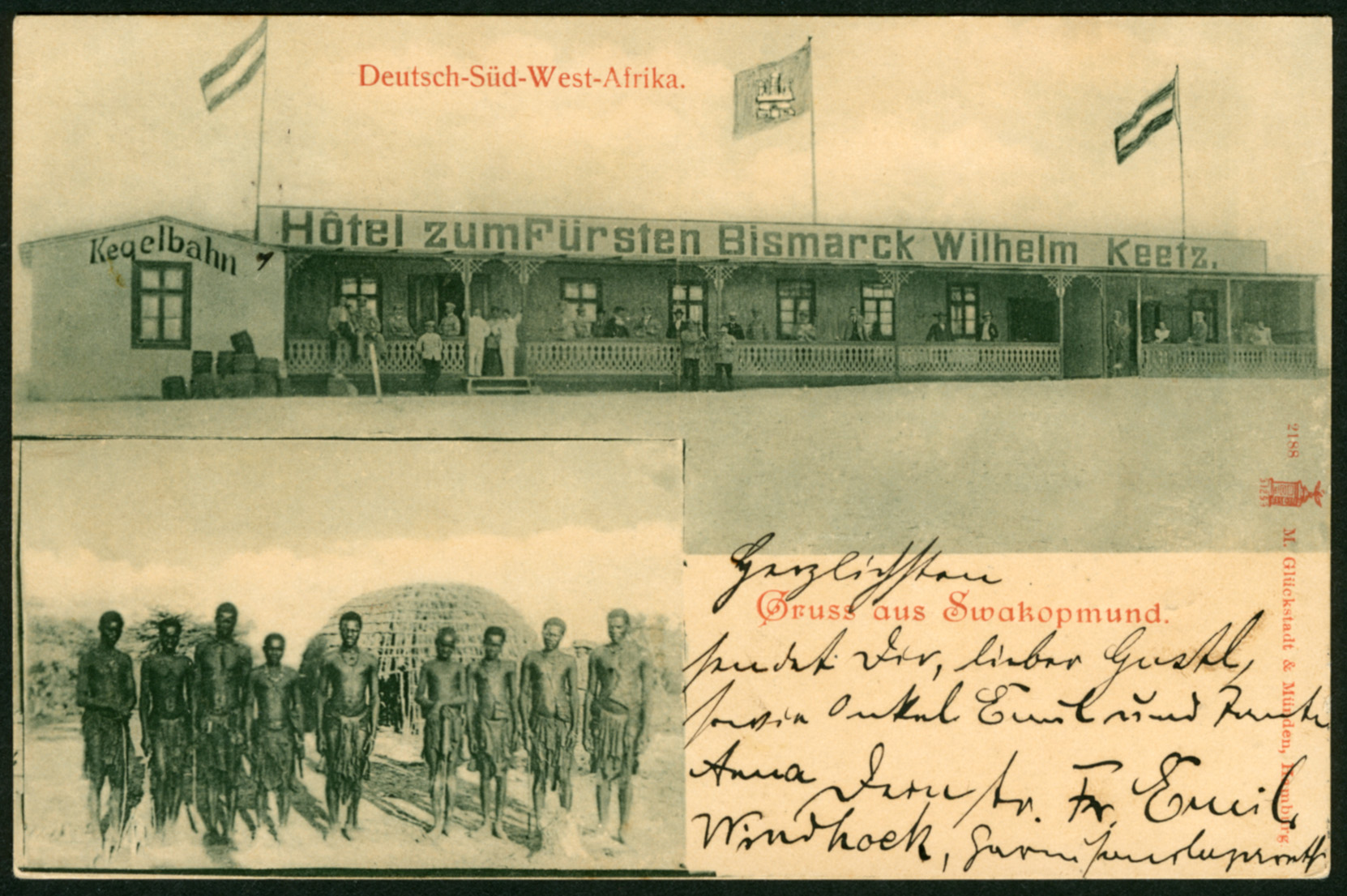
1900. Postcard. 'Greetings from Swakopmund'.
(2188. Verlag M. Gluckstadt & Munden, Hamburg'.)
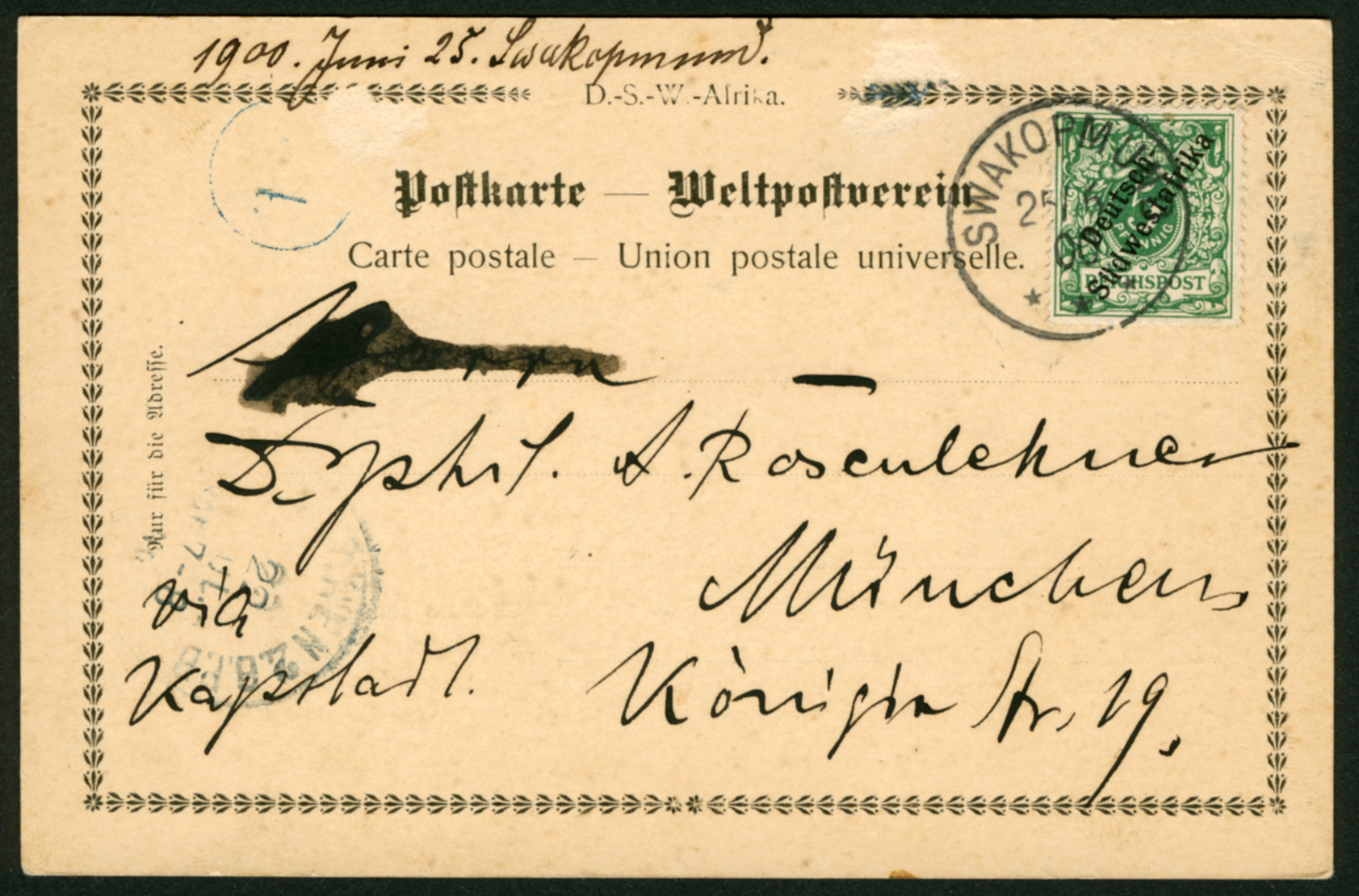
1900. 'SWAKOPMUND '25 / 6 00' to MUNICH, Germany.
Note: This is Swakopmund's first permanent datestamp.
The third postcard shows the German Military Hospital, 'The Lazareth'. in Windhoek. See next post. Unfortunately I cannot show it here because we are limited to five images per post.
Quote from Steve on July 9, 2025, 1:34 pmHere is the third postcard. This shows the German Military Hospital, the Lazareth, in Windhoek. The encapsulation of the image in a horizontal cartouche adds to its interest.
If, as I assume, 'Lazareth' is the German equivalent of 'Lazarus', this provides proof that the Germans have some sense of humour. Lazareth was the Biblical character that Christ brought back to life after being dead for four days. Perhaps the choice of this name for a German field hospital was cunningly intended to inspire German soldiers to fight to death on the field of honour in the certainty of resurrection in the field hospital. Whatever.... Nambia is dotted with the lonely graves of German soldiers who fell far from home and the hospital.
1900. Postcard. 'The Lazareth'. (Military Hospital). (No details.)
Of some possible interest is the mast centre right. This is possibly too early to be the Windhoek radio mast. Could it be a lightning conductor? Did the Germans have such? It appears to be fixed on the roof.
Here is a postcard showing Luderitzbucht (Ger. Luderitz Bay). You can see its radio mast in the foreground. It appears to be quite different to what we we can see in the postcard above. Also seen on the left is the spit of land known as Shark Island, a notorious and barbaric 'concentration camp' where indigenous people resisting German colonial rule were most cruelly confined and neglected. It is hard to imagine that the good burghers of Swakopmund could not see what was happening in their midst.
Circa 1906. Postcard. 'Luderitzbucht' (Nt. 113. GSWA.)
The radio masts are important to the history of GSWA because they were capable of transmitting messages to Germany via other stations, making them significant militarily assets. Britain asked the Union of SA government of General Louis Botha to invade GSWA in order to destroy the masts and or deny them to the Germans. The invasion would have great political repercussions in both SA and Namibia.
Here is the third postcard. This shows the German Military Hospital, the Lazareth, in Windhoek. The encapsulation of the image in a horizontal cartouche adds to its interest.
If, as I assume, 'Lazareth' is the German equivalent of 'Lazarus', this provides proof that the Germans have some sense of humour. Lazareth was the Biblical character that Christ brought back to life after being dead for four days. Perhaps the choice of this name for a German field hospital was cunningly intended to inspire German soldiers to fight to death on the field of honour in the certainty of resurrection in the field hospital. Whatever.... Nambia is dotted with the lonely graves of German soldiers who fell far from home and the hospital.
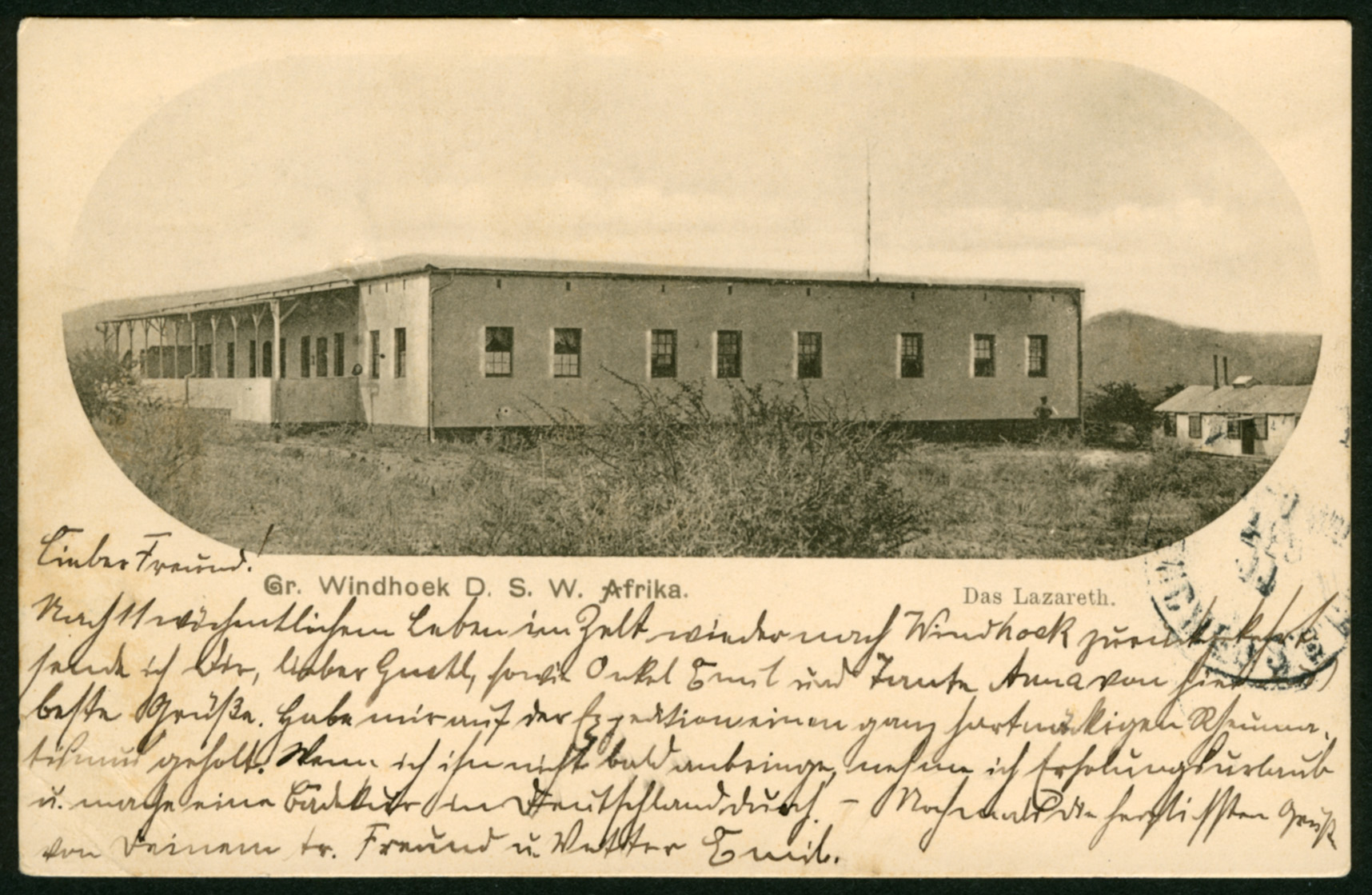
1900. Postcard. 'The Lazareth'. (Military Hospital). (No details.)
Of some possible interest is the mast centre right. This is possibly too early to be the Windhoek radio mast. Could it be a lightning conductor? Did the Germans have such? It appears to be fixed on the roof.
Here is a postcard showing Luderitzbucht (Ger. Luderitz Bay). You can see its radio mast in the foreground. It appears to be quite different to what we we can see in the postcard above. Also seen on the left is the spit of land known as Shark Island, a notorious and barbaric 'concentration camp' where indigenous people resisting German colonial rule were most cruelly confined and neglected. It is hard to imagine that the good burghers of Swakopmund could not see what was happening in their midst.
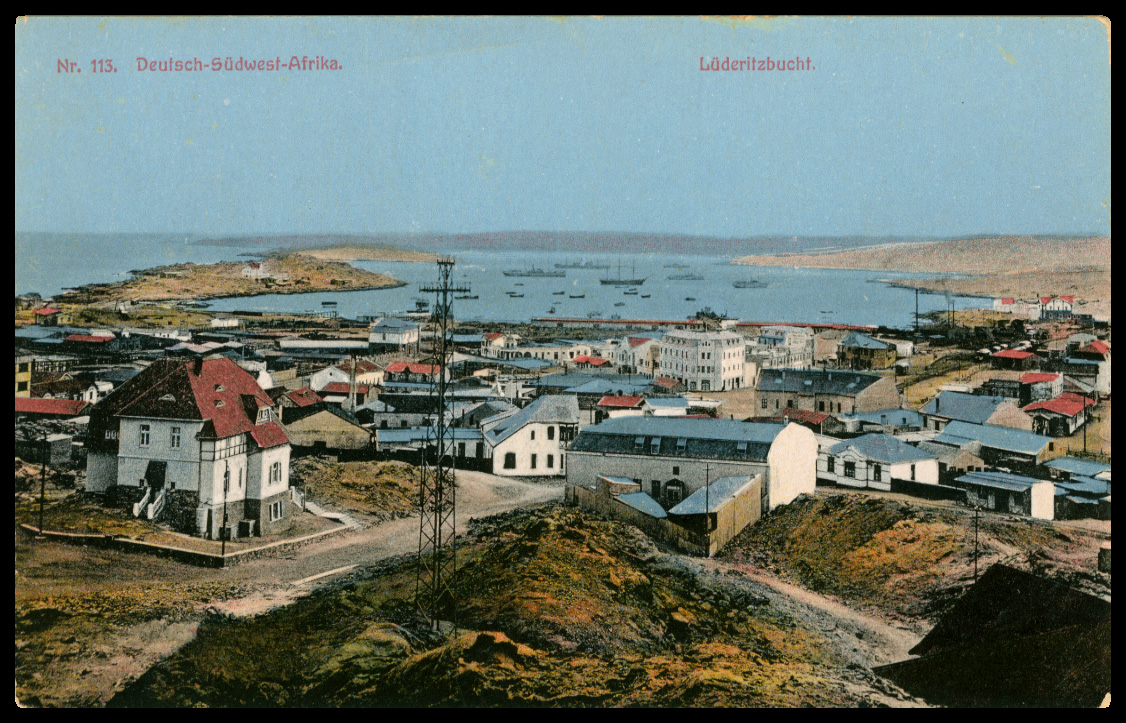
Circa 1906. Postcard. 'Luderitzbucht' (Nt. 113. GSWA.)
The radio masts are important to the history of GSWA because they were capable of transmitting messages to Germany via other stations, making them significant militarily assets. Britain asked the Union of SA government of General Louis Botha to invade GSWA in order to destroy the masts and or deny them to the Germans. The invasion would have great political repercussions in both SA and Namibia.
